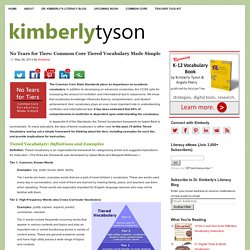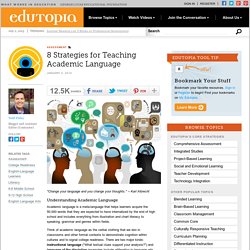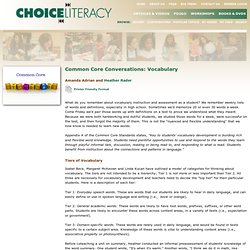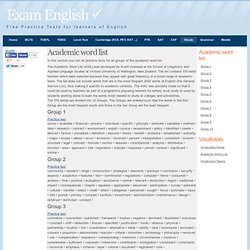

Why We Need to Grow Student Vocabulary. 11 Tips on Teaching Common Core Critical Vocabulary. Teaching vocabulary within the Common Core State Standards (CCSS) is an essential component of standards-based curriculum alignment.

Making the critical words second nature to our students will enhance achievement on assessments and will be useful in college and career. To process and store the academic vocabulary of the standards, our students’ brains require an efficient automatic memory system. This system, also called nonmotor procedural memory, stores information that is repeated, such as multiplication tables, song lyrics, words and definitions.
Following are 11 strategies, supported by education and memory research, for teaching critical CCSS words while keeping the cognitive verbs in mind: analyze, evaluate, compare, delineate, etc. Cognitive verbs require processing skills that are automatic (unconscious) to free up working memory space, the area in the brain that holds new information and connects it to long-term memory. Identifying the Best Words to Teach Notes. 3 Cool Digital Tools to Organize Your Classroom Library. Classroom libraries have come a long way to meet the needs of 21st century learners.

While some remain little more than a few books scattered on a bookshelf, many teachers have worked diligently to build a classroom library that supports balanced literacy instruction and independent reading. These libraries include both print and digital media and a diverse array of fiction, nonfiction, informational texts, authors, and varied genres and themes. Building a classroom library doesn’t have to break the bank. Teachers can use these 7 budget-friendly ideas (infographic here) to build their book collection. In addition, they can benchmark their current collection and use these research-based guidelines when growing and building their collection of materials. Organizing the classroom library is important, too. {12 Days: Tool 10} Infographic: Top 10 Characteristics of Effective Vocabulary Instruction.
21 Digital Tools to Build Vocabulary. If you follow this blog, you know that I believe effective vocabulary instruction is just about the most important instructional activity for teachers to get right. For lots of reasons. Vocabulary influences fluency, comprehension, and student achievement. How’s that for starters? In addition, a broad vocabulary is important for effective speaking, listening, reading and writing. Vocabulary is a foundational component of an effective K-12 comprehensive literacy framework. No Tears for Tiers: The CCSS Tiered Vocabulary Made Simple. The Common Core State Standards place an importance on academic vocabulary.

In addition to developing an advanced vocabulary, the CCSS calls for increasing the amount of nonfiction and informational text in classrooms. We know that vocabulary knowledge influences fluency, comprehension, and student achievement. And, vocabulary plays an even more important role in understanding nonfiction and informational text. It has been estimated that 80% of comprehension in nonfiction is dependent upon understanding the vocabulary. In Appendix A of the Standards, the Tiered Vocabulary framework by Isabel Beck is summarized. Academic Vocabulary Games. The Critical Words - Marilee Sprenger. 8 Strategies for Teaching Academic Language. "Change your language and you change your thoughts.

" -- Karl Albrecht Understanding Academic Language Academic language is a meta-language that helps learners acquire the 50,000 words that they are expected to have internalized by the end of high school and includes everything from illustration and chart literacy to speaking, grammar and genres within fields. Think of academic language as the verbal clothing that we don in classrooms and other formal contexts to demonstrate cognition within cultures and to signal college readiness. There are two major kinds: instructional language ("What textual clues support your analysis? ") and language of the discipline (examples include alliteration in language arts, axioms in math, class struggle in social studies and atoms in science). Where to Start It would be a mistake to think that academic language is a garbage pail category involving any word, depending on the context.
Effective Strategies for Teaching Vocabulary. Academic%20Word%20List. Developing_academic_vocabulary_lattimer_sml. Choice Literacy - Articles & Videos - Full Article. What do you remember about vocabulary instruction and assessment as a student?

We remember weekly lists of words and definitions, especially in high school. Sometimes we'd memorize 20 or even 30 words a week. Come Friday we'd pair those words up with definitions on a test to prove we understood what they meant. Because we were both hardworking and dutiful students, we studied those words for a week, were successful on the test, and then forgot the majority of them. Academic Wordlist. In this section you can do practice tests for all groups of the academic word list.

The Academic Word List (AWL) was developed by Averil Coxhead at the School of Linguistics and Applied Language Studies at Victoria University of Wellington, New Zealand. The list contains 570 word families which were selected because they appear with great frequency in a broad range of academic texts. The list does not include words that are in the most frequent 2000 words of English (the General Service List), thus making it specific to academic contexts. The AWL was primarily made so that it could be used by teachers as part of a programme preparing learners for tertiary level study or used by students working alone to learn the words most needed to study at colleges and universities. The 570 words are divided into 10 Groups. Group 1 Practice test Group 2 Practice test. VocabMarzanoFoldable - Powered by Google Docs.